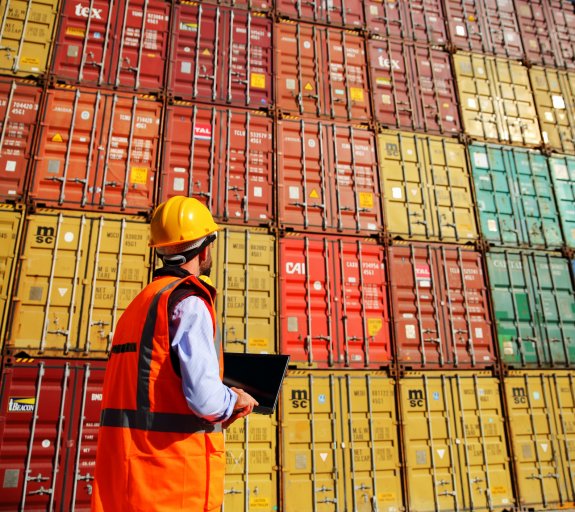
Will supply chains change for good?
- 11 May 2020 (5 min read)
The chances are you’re reading this article on a smartphone, tablet or other connected device. But have you ever paused to consider the journey that your device has been on before it touched your hands? From mined raw materials (such as gold and lithium) to assembly, manufacturing and then retail, your device travels along many stages of a long supply chain before it reaches you, the consumer.
The same process applies to all the products we buy. But until the onset of coronavirus, most of us wouldn’t have spent much time thinking about the links in the chain that bring us the goods we want. That changed when the pandemic hit, focusing investors’ minds on the ability of supply chains to function and meet the global demand for goods.
And those initial fears were well founded. The virus is transmitted by people, and the measures taken to contain it have confined huge swathes of people to their homes. Those same people play a vital role in the corporate supply chain, which functions less efficiently without them. With populations under lockdowns, decreased air freight and new border controls, the effect on businesses of all types is profound.
In the autos sector, for example, Fiat, Jaguar Land Rover and BMW (among others) were forced to close their European plants. The supply chain and assembly process for cars is exceedingly complex, involving an estimated 20,000 components made in around 30 countries. Elsewhere, Apple requires circuit boards and chips for its iPhones, some of which are manufactured in Malaysia. The lockdown affected some of its Malaysian suppliers, which in turn cast doubt on Apple’s ability to keep up with its production schedule1 . When such an iconic and large company is having problems, everyone pays attention.
Closer to home, we’ve seen the effects of supply-chain worries in our local supermarkets. Impulsive panic buying and food hoarding by shoppers was exacerbated by reports that suppliers would be affected by the measures to curtail the virus. And although those concerns have since eased, the initial supply shock has prompted business leaders in various sectors to question the structure and durability of their supply chains.
Reliance on cheap labour and parts from China is also under particular scrutiny. China’s pre-eminence in manufacturing is well established – it produces 80% of the world’s circuit boards (essential components for smartphones) and almost 30% of all manufactured products. However, those businesses reliant on supply from China are recognising that the economic benefit of cheap labour and goods may not be enough to fully compensate for the risk of not being supplied at all2 .
This view plays well into US President Donald Trump’s ‘Make America Great Again (MAGA)’ rhetoric. Back in March, the US commerce secretary, Wilbur Ross, remarked that the coronavirus would “help accelerate” the return of jobs from offshore locations to the US3 . Nevertheless, it remains to be seen whether this viewpoint will gather traction among business leaders. Following on the heels of the US-China trade war, such comments could influence businesses to consider ‘nearshoring’ (transferring business operations closer to home).
For investors, the onset of the pandemic and the associated supply shock fuelled the widespread falls in equity markets we saw in February and March. Although markets have since stabilised somewhat, the fragility in some supply chains has raised questions that are unlikely to go away. As investors, we must work to ascertain the long-term opportunities and threats that will arise. We continue to focus on domestic and internationally exposed UK-listed businesses, where the fundamental profit drivers are entrenched, and equity holders benefit from management’s capital allocation and risk-taking.
- aHR0cHM6Ly93d3cuYnVzaW5lc3NpbnNpZGVyLmNvbS9jb3JvbmF2aXJ1cy1hcHBsZS1zdXBwbHktY2hhaW4taXBob25lLTEyLXByb2R1Y3Rpb24tMjAyMC0z
- aHR0cHM6Ly93d3cuaXBzLWpvdXJuYWwuZXUvcmVnaW9ucy9ldXJvcGUvYXJ0aWNsZS9zaG93L2NvdmlkLTE5LWZvcmNlcy1ldXJvcGUtdG8tcmV0aGluay1nbG9iYWxpc2F0aW9uLTQzMTAv
- aHR0cHM6Ly93d3cuZnQuY29tL2NvbnRlbnQvNWU5MzNmY2UtNjJiYi0xMWVhLWIzZjMtZmU0NjgwZWE2OGI1
Not for Retail distribution
This document is intended exclusively for Professional, Institutional, Qualified or Wholesale Clients / Investors only, as defined by applicable local laws and regulation. Circulation must be restricted accordingly.
This document is for informational purposes only and does not constitute investment research or financial analysis relating to transactions in financial instruments as per MIF Directive (2014/65/EU), nor does it constitute on the part of AXA Investment Managers or its affiliated companies an offer to buy or sell any investments, products or services, and should not be considered as solicitation or investment, legal or tax advice, a recommendation for an investment strategy or a personalized recommendation to buy or sell securities.
It has been established on the basis of data, projections, forecasts, anticipations and hypothesis which are subjective. Its analysis and conclusions are the expression of an opinion, based on available data at a specific date.
All information in this document is established on data made public by official providers of economic and market statistics. AXA Investment Managers disclaims any and all liability relating to a decision based on or for reliance on this document. All exhibits included in this document, unless stated otherwise, are as of the publication date of this document. Furthermore, due to the subjective nature of these opinions and analysis, these data, projections, forecasts, anticipations, hypothesis, etc. are not necessary used or followed by AXA IM’s portfolio management teams or its affiliates, who may act based on their own opinions. Any reproduction of this information, in whole or in part is, unless otherwise authorised by AXA IM, prohibited.
Issued in the UK by AXA Investment Managers UK Limited, which is authorised and regulated by the Financial Conduct Authority in the UK. Registered in England and Wales, No: 01431068. Registered Office: 22 Bishopsgate, London, EC2N 4BQ. In other jurisdictions, this document is issued by AXA Investment Managers SA’s affiliates in those countries.
Risk Warning
The value of investments, and the income from them, can fall as well as rise and investors may not get back the amount originally invested.